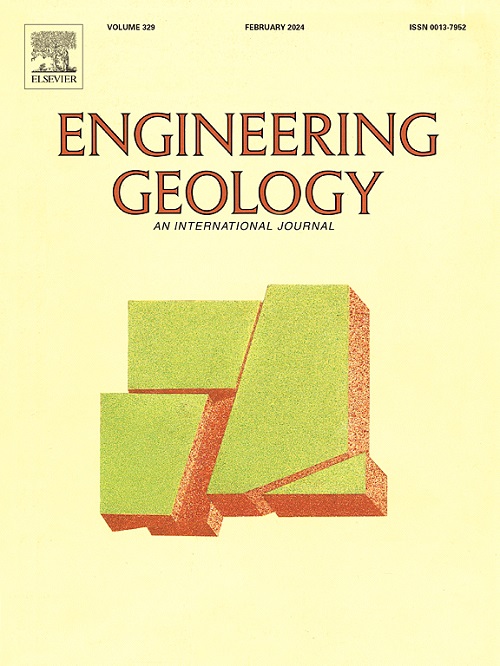Integration of seasonal frequency domain electromagnetic surveys and geological data for assessing the integrity of earthen levee systems. The case study of the Panaro River (Northern Italy)
IF 6.9
1区 工程技术
Q1 ENGINEERING, GEOLOGICAL
引用次数: 0
Abstract
Floods rank among the most widespread and destructive natural hazards worldwide. The progressive degradation, impairment, and breach of earthen riverine levees can occur in both natural and anthropogenic environments, stemming from various scenarios or sequences of events. These may include hydraulic failure due to overtopping because of inadequate height, and structural failure occurring even prior to overtopping, due to insufficient geotechnical and hydraulic characteristics combined with external and internal erosion.
Following the catastrophic flood of December 2020, caused by the collapse of a section of the levee system of the Panaro River (a tributary of the Po River, Northern Italy), local Authorities initiated a comprehensive investigation into the causes of the breach. Numerous factors, including geological, geomorphological, and ecological features, were found to have contributed to the progressive decrease of the levee integrity prior to and during the flood. This prompted a broader multidisciplinary study of the Panaro River levee system.
The study expanded its focus to include the collapsed section (rebuilt in 2020), as well as an additional 30 km stretch of both the right and left levees north of Modena, totaling 60 km. Detailed geological and geophysical data were integrated into the analysis, with particular emphasis on evaluating the characteristics and integrity features of the levee system.
This analysis was carried out using Frequency Domain Electromagnetic Methods (FDEM) on the top of the levees, previously calibrated using Electrical Resistivity Tomography (ERT), geological mapping, core logs, and Cone Penetration Tests (CPTs). The FDEM surveys were repeated in different environmental conditions, specifically in the dry 2021 summer season and in the wet 2023 spring season, during heavy rainfalls that caused disastrous floods in several areas of the Emilia-Romagna Region. Out of the 60 km surveyed in the study area, the comparison of the two datasets highlights an interval of about 4 km where the internal portion of the levees is characterized by relatively coarse-grained materials and higher permeability making it more prone to internal erosion phenomena. This paper describes and integrates the results of these investigations, drawing attention to the strengths and limitations of the FDEM method when applied to extensive surveys on earthen riverine levee systems. The proposed methodology contributes as well to maintenance and retrofitting efforts to reduce flood risk in the context of the present climate change scenarios.
整合季节性频域电磁勘测和地质数据,评估土堤系统的完整性。帕纳罗河(意大利北部)案例研究
洪水是全球范围内最广泛和最具破坏性的自然灾害之一。在自然和人为环境中,土质河堤都可能因各种情况或事件序列而逐渐退化、受损和溃决。2020 年 12 月,帕纳罗河(意大利北部波河的一条支流)的一段堤坝系统垮塌,引发了灾难性的洪水,此后,当地政府对垮塌原因展开了全面调查。调查发现,包括地质、地貌和生态特征在内的众多因素导致了洪水之前和洪水期间堤坝完整性的逐步降低。这项研究将重点扩大到坍塌段(2020 年重建)以及摩德纳以北 30 公里的左右堤坝,总长 60 公里。该分析使用频域电磁法 (FDEM) 在堤坝顶部进行,之前使用电阻率断层扫描 (ERT)、地质绘图、岩心记录和锥形穿透测试 (CPT) 进行了校准。在不同的环境条件下重复进行了 FDEM 勘测,特别是在 2021 年夏季的干燥季节和 2023 年春季的潮湿季节,当时的暴雨在艾米利亚-罗马涅大区的多个地区造成了灾难性的洪灾。在研究区域 60 公里的勘测范围内,通过对比两个数据集,发现约有 4 公里的堤坝内部由颗粒相对较粗的材料构成,渗透性较高,因此更容易发生内部侵蚀现象。本文介绍并整合了这些调查的结果,提请注意 FDEM 方法在应用于土质河道堤坝系统的广泛调查时的优势和局限性。在当前气候变化的背景下,所提出的方法也有助于维护和改造工作,以降低洪水风险。
本文章由计算机程序翻译,如有差异,请以英文原文为准。
求助全文
约1分钟内获得全文
求助全文
来源期刊

Engineering Geology
地学-地球科学综合
CiteScore
13.70
自引率
12.20%
发文量
327
审稿时长
5.6 months
期刊介绍:
Engineering Geology, an international interdisciplinary journal, serves as a bridge between earth sciences and engineering, focusing on geological and geotechnical engineering. It welcomes studies with relevance to engineering, environmental concerns, and safety, catering to engineering geologists with backgrounds in geology or civil/mining engineering. Topics include applied geomorphology, structural geology, geophysics, geochemistry, environmental geology, hydrogeology, land use planning, natural hazards, remote sensing, soil and rock mechanics, and applied geotechnical engineering. The journal provides a platform for research at the intersection of geology and engineering disciplines.
 求助内容:
求助内容: 应助结果提醒方式:
应助结果提醒方式:


